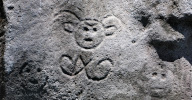| Kaz | Enfo | Ayiti | Litérati | KAPES | Kont | Fowòm | Lyannaj | Pwèm | Plan |
| Accueil | Actualité | Haïti | Bibliographie | CAPES | Contes | Forum | Liens | Poèmes | Sommaire |
Haitian Studies Association 18th Annual Conference
18th Annual Conference
October 5-7, 2006 - University of Virginia, Charlottesville, VA.
SECTION: Standardizing Haitian Creole?
A Roundtable Discussion
[Friday, October 6, 1:30-2:45 pm - Session 2–B, South Meeting Room, Newcomb Hall ]
- Chair: Albert Valdman, Indiana University, Bloomington, IN
- Panelists: Emmanuel W. Védrine, Independent Writer, Boston, MA
- Josianne Hudicourt-Barnes, TERC, Boston, MA
- Marc Prou, University of Massachusetts, Boston, MA.
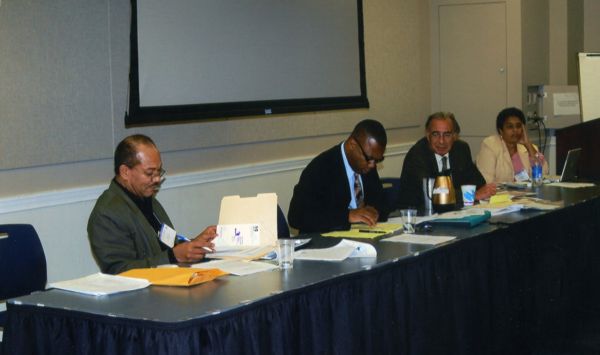 |
From left to right: M. Prou, E. W. Vedrine, A. Valdman, J. Barnes-Huducourt. (photo credits: Dr. Jose Védrine, Marky Jean-Pierre) |
Presentation by E.W.Védrine
TITLE: A Hidden Norm In The Standardization Process Of Haitian Creole That Would Be Acceptable By The Whole Haitian Population And How to Manage It
(Une Norme Sous-Ententendue Dans Le Processus De La Standardisation Du Créole Haïtien Qui Serait Acceptable Par Toutes Les Couches Sociales De La Population Haïtienne et comment la gérer)
1 . A quick look at the HISTORY of Haitian Creole Writings system up to 1979 and other problems to look at (e.g., morphology, writing new terms, neologisms, borrowings, linguistic ideology, etc.). Yves Déjean’s Dissertation as main research to look at (“Comment écrire le créole d’Haïti”1. Ph.D dissertation presented at the French dept. Indiana University. 1997 (Albert Valdman, dissertation director)
II . Creole as a second official language of Haiti2 on par of French and WHAT???
III . The use of Creole in schools in Haiti (use of urban variation and the tendency to reject the rural variation) - Sociolinguistics and the reality behind it. See below a list of rural vs. urbant variants.
SAMPLE OF RURAL VARIANTS (left) vs. URBAN VARIANTS (right)
| 1. anvan (*) /avan | 11. dibout /debou | 21. hadi /radi | 31. lò /lè |
| 2. asizonnen /asizone | 12. dirèktè /direktè | 22. hadiyès /radiyès | 32. lòt jou /lotrejou |
| 3. bije /oblije | 13. dòktè /doktè | 23. hale /rale | 33. panyen /panye |
| 4. chimen /chemen | 14. douvanjou/Avanjou |
24. ganyen /genyen | 34. penmèt /pèmèt |
| 5. chimiz /chemiz | 15. fenmèl /femèl | 25. hou /wou (zouti) | 35. pweson /pwason |
| 6. chòdyè /chodyè | 16. fènwè(*) /fènwa | 26. jouk ki lè /jis ki lè | 36.pwezonnen/pwazonnen |
| 7. chonje /sonje | 17. fiyòl /fiyèl | 27. kouman /kòman | 37. sanmdi /samdi |
| 8. chwal /cheval | 18. fouye dife /fwaye dife | 28. koumanse /kòmanse | 38. senmenn /semèn |
| 9. denmen /demen | 19. gouvèlman/gouvènman | 29. Lanmè(*) /lamè | 39. swate /swete |
| 10. denpi /depi | 20. had /rad | 30. Larivyè /rivyè | 40. swedizan /swadizan |
1. before. 2. to season (meat, etc.). 3. to be obliged. 4. road, way. 5. shirt. 6. pan. 7. to remember, to recall. 8. horse. 9. tomorrow. 10. since. 11. up (standing up). 12.director. 13. doctor. 14. dawn, early in the morning. 15. female (animal) 16. darkness. 17. godchild. 18. fire place. 19. govern ment. 20. cloth. 21. disrespectful 22. disrespect 23. to pull 24. have 25.--- 26. until when 27. how 28. to begin, to start. 29. sea. 30. river. 31. when. 32. the other day. 33. basket. 34. to allow. 35. fish. 36.to poison. 37. Saturday. 38. week. 39. to wish. 40. so-called.
*Note: Some of these doublets can be interchangeable in the native speakers's speech and may just be considered as "variant" instead of "rural variant".
IV .The Haitian press (mostly RADIO [“presse parlée”] since the whole population has access to it) and its influence on the population (in terms an acceptable HIDDEN NORM) .
V . The Importance Of ELECTRONIC PUBLICATIONS & The Role Of COMPUTATIONAL LINGUISTICS in The Process of standandardizing Haitian Creole (analysis of data from a wide-range of CORPUS / METACORPUS [e.g. Albert VALDMAN (Indiana University), BON NOUVÈL (since 1967), Bryant FREEMAN / Jowel LAGUERRE (Kansas University & data shared with Faculté de Linguistique de Port-au-Prince, directed by Pierre Vernet), Dominique FATTIER (thèse de doctarat d'état "Contribution A L'étude De La Génèse Du Créole: L'Atlas Linguistique d'Haiti Cartes Et Commentaires"6 (6 volumes). Université de Provence, Institut d'Études Créoles. The Electronic D-base of E.W.VEDRINE's writings in Haitian Creole, EDUCA VISION (D-base), HAITI PROGRÈS (sample edited by E. W. Védrine), HENRY DESCHAMPS (Creole D-base), SCANNING / COMPILATION OF Haitian Creole texts by Marilyn MASON & Jeff ALLEN (reviewed by Yves DEJEAN and Michel DEGRAFF), Creole D-base by E. TROUILLOT (Univ. Caraïbe). If all these WORKS and others can merge, certainly, that can serve the most important tool for MONOLINGUAL DICTIONARIES (Kreyòl-Kreyòl). See sample.]
VI. A look at Haiti’s linguistic situation (La situation linguistique en Haïti par Michel St-Germain, Faculté d'Éducation Université d'Ottawa) for general knowledge
BOOKS BY E.W.VEDRINE
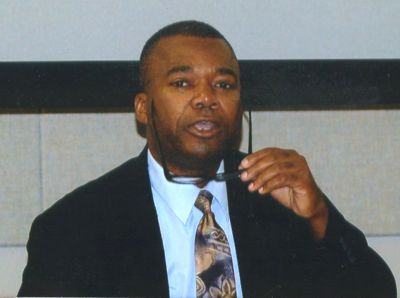 |
1. Dictionary of Haitian Creole Verbs with phrases & idioms (1992), 246p
2. Un stylo international (poetry, 1993), 61p
3. Ide pou kreye yon high school ayisyen prive nan Boston (1994), 102 p.
4. Poetry in Haitian Creole (1994), 75p
5. Materyèl Edikatif pou Bileng Ayisyen (1994), 218p
6. Yon koudèy sou pwoblèm pwoblèm lekòl Ayiti3 (1994), 117p
7. Ti istwa kreyòl: Short stories in Haitian Creole4 (1994), 115p
8. Sezon sechrès Ayiti (novel, 1994) 128p
9. Petit lexique du créole haïtien (historical linguistics) (1995)
10. 23 Poèmes en français et haïtien5 (poetry, 1995), 52p
11. Koze Lanmou I (poetry), 48p
12. Gramè Kreyòl Védrine (1996), 354p
13. Kreyòl Lesson for beginners: An introduction to Haitian Creole (1996)
14. Men l anlè a l ap vini (short story, 1996) 34p
15. An annotated Bibliography on Haitian Creole: a review of publications from colonial times to 2000 (2003), 700p
16. A bibliography of theses and dissertation related to the Dominican Republic (co-editor, 2005). 276p
17. Di yon vèb, tire yon kont (riddles in Haitian Creole, 2nd. ed. 2006), 125p
COMING SOON
18. A healing paradigm for a new Haiti (essay)
19. Koze lanmou: Pages d'amour (poetry)
20. Ideas to found a private Haitian High School in Boston (translation, debate)
21. Premye etap avèk yon òdinatè (co-editor)
22. Season of drought in Haiti (novel)
ASSISTANT EDITOR
Haitian Creole-English Bilingual Dictionary (HCEBD). The Indiana University, Creole Institute (2007)
Note
- DEJEAN, Yves. 1977. “Comment Écrire Le Créole D'Haïti”. Indiana University. Degree: Ph.D. 554 p. + 1 page of the author's curriculum vitae. [Linguistics, Creole; Linguistics Haitian; Linguistics, Applied. Thesis also published in 1980 by Collectif Paroles (Canada). His linguistic publications appear in numerous journals and reviews both abroad and in Haiti. - Aménagement linguistique; Créole (description); Écriture; Phonétique-Phonologie. -- "Travail fondamental sur l'évolution de l'orthographe du créole haïtien: historique de la représentation graphique du créole à partir de la période coloniale, y compris les tentatives gallo-centriques non-systématiques; discussion des traits phonologiques du créole dans la perspective de l'élaboration d'une représentation graphique autonome à base phonologique; justification de l'emploi de l'orthographe Faublas-Pressoir comme système de représentation adéquat" (É. C. à Aix) [KRE]
- Creole as a SECOND OFFICIAL LANGUAGE of Haiti (on par of French) and what?
The Constitution of 1987 stipulates only one language unites all Haitians – it is the Kreyòl language. The same Constitution recognizes Kreyòl as another official language on par with French. The linguistic situation of Haiti has been (up to now) a diglossia where French or Kreyòl can be looked at as a dominant language in some cases. For instance, most of the official documents, including teaching materials, are still written in French. There is a need to render them in Kreyòl. There have also been a great number of teaching materials in Kreyòl (from the last twenty years) covering the elementary and middle school cycles. And now, there are also Haitian researchers and educators in the Diaspora who are developing materials for Haitian Bilingual Programs (elementary, middle and secondary level). Despite all these types of activities, the real change remains in the hands of the government – not only to build free school throughout the country, but also to promote teaching and literacy programs in the Kreyòl language first and try to work toward a solid bilingual program. The day this dream becomes a reality – when all children in Haiti will be able to attend schools freely, to learn how to read and write in their native language, and to master it before learning a second language, education will be agreat step in the development of the country and of the genuine movement for schools reform sought by many conscious Haitians. (Emmanuel W. Védrine, 2003)
- Yon koudèy sou pwoblèm lekòl Ayiti [A look at the problem of schools in Haiti]. – Essays on the problems of schools in Haiti and interviews with some Haitian educators from the diaspora. A textbook for educators, students (high school and college level) and researchers.–
E. LE PHARE: We have talked about you as a novelist, but we can't go talking only about novels because that's not only what you write. Let's touch on another important interest: you work with schools both here in Boston and in Haiti. If we look at the problems of schools in Haiti, the first thing I noticed while reading this book, is how clearly you bring forth the important issues of education: the issue of writing and speaking Kreyol, the issue of bilingual curriculum, the tensions between French and Kreyol in educational settings here; all of this leads me to the question of development and progress. Is your project based on two strategies: to make people conscious of the reality of bilingualism in our community and to impress upon educational teachers the need to study and apply more seriously the work of bilingualism in both Boston and Haiti?
Emmanuel W. VEDRINE: The work that I have done in Yon koudey sou pwoblem sou pwoblem lekol Ayiti was partly motivated by my work as a teacher in the Haitian Bilingual Program in Boston. However, my work is very much directed at the challenges of education in Haiti. It is a habit of mine to return to Haiti in order to analyze some of the problems within the school system there. As you know, there are so many problems within Haitian schools and my return to Haiti helps me to really understand or show the readers, students, and teachers the problem and its source so they can be able to analyze and propose solutions.I discuss the language issue in order to bring enlightenment on both French and Kreyol. We know that in Haiti during the 30-year dictatorship, the educators in Haitian never really talked about the serious problems of Haitian education. In fact, one of the confusions that have been propagated is the exaggerated concern between French and Kreyol in order to avoid showing that it's politics that causes the major problems and not whether the school is committed to French or Kreyol. As a linguist, I contend that the problem of language is important, but secondary to the reality of politics. It is politics that can create the conditions for educational quality and opportunity in Haiti and not what language one speaks. Language is just a medium; you can use any language in education. So, the real problem is not really one between French and Creole, the way many educators in Haiti used to show it in order to avoid touching on the political reality and how it really defines the contours of our educational expectations.
I take my position on that and at the same time as linguist and Haitian writer who cares deeply about Haitian reality, I feel that I have a responsibility to do a job that would advance Kreyol language as the main language medium in the educational system in Haiti. Further, I try to advance Kreyol in the Haitian Diaspora in all bilingual programs. I do believe in what I am doing and I strand firmly on it. On the issue of language again, we must not forget the attitudes that we are sometimes dealing with when some Haitian teachers put forth negative attitudes against Kreyol language. That is another problem we can analyze and why some teachers insist upon using only French as the language for Haitian students. So, they don't see the use of Kreyol language as a medium to help Haitian children in their transition in bilingal program. Bilingualism is under scrutiny in the Diaspora while Kreyol is the Haitian educational structure is under scrutiny as the official language there. Negative attitudes in both the Disapora and Haiti about Kreyol language must be changed. Language then is the crucial link waiting in the wings to come forth and do its job in Haiti once Haitian politics restructure an educational system for sustained excellence. Kreyol is the native language and it must be respected and officially used. I stand by that. Also, I think that the Diapora can play an important role in helping to accomplish that goal because, for instance, in Boston, though there is resistance by some Haitian educators, the fact remains that Kreyol language is used in the Boston School System as the official language of Haitian students who are in bilingual programs. (Excerpt of an interview with k Eddy Le Phare. “Radyo Liberasyon”, Boston. Feb. 5, 1996).
- Ti istwa kreyòl: Short stories in Haitian Creole. Seven short stories in Creole (“Yo kenbe Bouki andedan vant yon bèf” [They catch Bouki inside a cow], “Konpè Chat ap dirije yon lekòl” [Konpè Chat is a school’s principal], “Yon chat de pye ak yon enkoutab” [A two-feet cat and and an “enkoutab”], “Chanje lide” [Changing one’s idea], “Yon manman poul touye yon malfini” [A hen kills a hawk], “Elefan prezide yon konferans sou pwoblèm bèt sovay t ap konfwonte, “Gade yon mirak” [Look! A miracle!]) with questions and exercises on each story, including a Haitian proverbs section (on animals) and a Creole-English glossary. Illustrated by the author. A textbook for middle and high school level, for native speakers and learners of Haitian Creole.
- The purpose of this book is to allow greater access to those interested in Kreyòl and English. As a guide for speakers of both languages, it can be used for different purposes.
- Following each story is a list of questions, vocabularies and expressions for exercises. There is also a section on illustrated Haitian proverbs dealing with animals, and finally a Kreyòl.
- English glossary that can be useful to English speakers. I hope that Ti istwa kreyòl: Short stories in Haitian Creole will be a good guide to anyone using it.
- 23 Poèmes en français et en haïtien. [Afrika oh! Afrika oh!: Afrika! Afrika; Dans la forêt Noire: Nan Forè Nwa; Europe et Espagne: Ewòp ak Espay; Le voyageur: Vwayajè; Les deux Ponts: Pon Nèf ak Pon Women; Salamanca: Salamank; Souvenir de Vienne: Souvni k sot Vyèn; Vive les vacances: Viv vakans!; Au bord de l'Océan: Bò Oseyan an; Ce que tu dois savoir: Sa ou dwe konnen; Dans le Parc: Nan Pak la; L'existence et la puissance de l'amour: Ekzistans ak puisans lanmou; Souvenir: Souvni; L'alpha et l'omega: Premye ak dènye; L'enfant et sa mère adoptive: Pitit ak manman adoktif li; L'Haïtien et le Chinois: Ayisyen ak Chinwa; L'Haïtien, un metis: Ayisyen, yon metis; L'Oiseau et le printemps: Zwazo ak prentan; Où se trouve Haïti?: Kikote Ayiti ye?; Qui vous êtes: Kisa ou ye?; Saison Rouge: Sezon Wouj; Trente ans emprisonné: Trantan anprizone; Un temoin: Yon temwen.]
«Ayant longtemps vécu dans un milieu où la parole n'est pas tout à fait emprisonnée, Emmanuel W. Védrine s'est échappé de la poésie codée qu'offrent généralement les poètes d'Haïti pour nous livrer un message clair, simple, facile. C'est un poète badin qui chante tel un enfant. Sa poésie est toute pleine d'adolescence et naïveté. - Védrine nous raconte ses voyages, ses nombreux séjours en Europe. Pour avoir étudié en Allemagne et en Espagne, il a eu le privilège de découvrir et d'admirer de beaux sites européens. En été, il parcourt villes et villages, frotte avec de nombreuses cultures.Il y a beaucoup de raisons
Qui poussent les gens à voyager
écrit Védrine. Les études donc ne sont pas les seules raisons de ses voyages. Il y a surtout le confort romantique des lieux tel SALAMANCA , en Espagne où
les oiseaux volent loin,
Bien loin de RIO TORMES
où PLAZA MAYOR le convaince à s'asseoir et à promener dans son enceinte… Vienne parait une ville particulière pour le poète. Les habitants sont si sympathiques. On les croise dans les rues. Ils vont vite, certes. Cependant, ils ont le temps de vous saluer et de vous acceuillir.
Les gens sont gentils à Vienne
Védrine est le poète des vacances fleuries. Il chante la beauté d'une nature universelle. BOSTON, VIENNE, FREIBURG et plus particulièrement SALAMANCA retentissent à travers ses chants. - Haïti n'a pas fait table rase dans l'univers poétique de Védrine. Au fond de son cœur, une large place y est reservée. Le poète se complaint de la misère du pays, dénonce le système impérialiste-colonialiste, se révolte contre les bourreaux du peuple.
Certains ‘doctes' de la poésie auraient tendance à penser que l'écriture de Védrine parait trop simpliste… On aurait tendance à croire qu'une légèreté se fait sentir de part et d'autre dans les texte. Haltez-vous!… Védrine sait parfaitement bien ce dont les anglophones ont besoin pour mieux apprendre et comprendre le créole et le français. S'il a choisi ce langage… c'est pour se faire mieux comprendre par le public au milieu duquel il vit et pour lequel d'abord il écrit…». (Jean Armoce Dugé).
- [FATTIER, Dominique. "Contribution à l'étude de la genèse d'un créole: L'Atlas Linguistique D'Haïti cartes Et commentaires". Université de Provence, Institut D'Étude Créoles. Thèse de doctorat d'état. ["L'objet de cette thèse est double: il s'agit de proposer un grand corpus d'haïtien parlé, tout en tenant, par le commentaire du corpus, d'éclairer la genèse de cette langue. L'enquête a porté sur 20 localités du milieu rural où ont été interrogés des témoins unilingues. L'enquête a permis de constituer une banque de données fiables. La plus grande partie de la thèse est dédiée aux commentaires (vol. I et II) associés aux cartes (vol. III, IV, V, VI). Cet ensemble est accompagné d'une introduction, de conclusions, de deux index et d'une bibliographie. Nous nous sommes intéressés par dessus tout aux implications génétiques découlant de l'examen des données géolinguistiques. Ce qui explique qu'en règle générale, dans les commentaires, l'accent soit mis sur l'analyse diachronique et comparative. Nous avons cherché à mettre en évidence, de façon systématique, le rôle du français (koïnè d'oïl) dans la formation du créole haïtien. L'examen du matériau linguistique collecté a permis de progresser dans la compréhension du phénomène de la créolisation. Le résultat le plus saillant de l'étude est la mise en évidence du caractère massif de l'héritage français. Nous avons accordé moins d'attention au rôle des langues de l'Afrique de l'Ouest, sauf dans quelques commentaires et dans les conclusions où se trouve explicité ce qui a pu être des influences africaines au plan sémantique et syntaxique."
"The Linguistic Atlas of Haiti, Maps and Commentaries: Contribution to the Study of the Genesis of a Creole Language.
The purpose of the study is twofold: first, to elucidate the general processus of creolization of language in Haiti; second, to provide empirical input for further works. Our study centered on 20 localities. The methodology consisted of extensive interviews with illiterate unilingual peasants. The Atlas brings together authentic data. The major part of this thesis is taken up my map's commentaries (Vol. I and II) and maps (vol. III, IV, V, and VI). The whole is rounded off with an introduction, a few conclusions (pp. 974-992), two index (pp. 993-1016) and a bibliography (pp. 1017-1029). We were interested, above all, in the genetical implications that ensued from dialect investigation using the geolinguistic methods of dialect analysis. In general, in the commentaries, emphasis is laid upon diachronic and comparative study. Of special interest to us was the role or influence of French (koïnè d'oïl) in the formation of Haitian Creole (HC). The storehouse of information on dialects that has been compiled has attributed significantly to our understanding of the creolization phenomenon. The most important finding is the major role of the French Language in the genesis of HC. Relative little attention was paid to West African influences, except in part of some commentaries, and in conclusions that discussed the African legacy. Both of the syntax and the semantics of HC show West African reflexes."]
COMMENTS ON E. W. VEDRINE WORKS
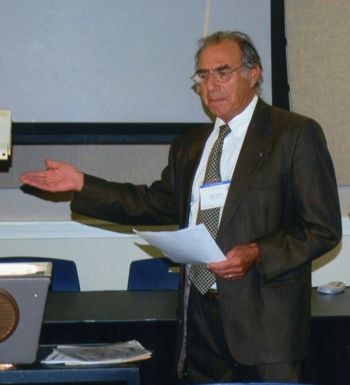 |
A. Valdman |
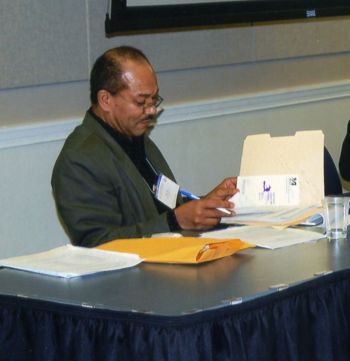 |
M. Prou |
 |
J. Barnes-Huducourt |
